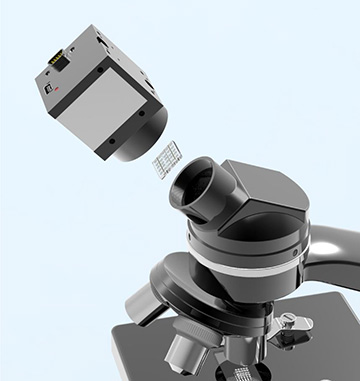![]()
The “SmartLens” concept of a research team from ICFO, Spain, and the Institut de la Vision, France, uses tiny embedded electrical microheaters to change the local refractive index within a thin polymer, and thereby allow custom wavefront shaping. [Image: ICFO/Marc Montagut]
The development of ever more compact optics for imaging—ranging from smartphone cameras to sophisticated tools for astronomy and biomedicine—often boils down to compromises between size, image quality and cost. Achieving sharper images generally means adding bulky optical elements, or integrating highly effective but potentially costly wavefront-shaping components such as spatial light modulators (SLMs) or deformable mirrors.
Researchers in Spain and France have now devised a very different alternative for tunable wavefront control (Nat. Photon., doi: 10.1038/s41566-019-0486-3). The alternative involves a thin lens that embeds an electrical microheater, which can locally alter the refractive index of the lens and enable on-the-fly, freeform adjustment of the optical wavefront. The researchers believe that arrays of the device—which the team has dubbed the SmartLens—could be “incorporated into a wide variety of optical instruments,” such as microscopes, to dynamically correct for aberration.
The many routes to wavefront shaping
The adaptive-optics revolution of the past several decades has rested largely on two core wavefront-shaping tools, SLMs and deformable mirrors. But remarkable as these tools are, they have their shortcomings. SLMs are pricey and polarization- and wavelength-sensitive, which has limited their use in some imaging applications. And deformable mirrors are complex to manufacture and costly as well.
Another approach to wavefront shaping lies in broadband tunable lenses, which have undergone substantial recent development and can be quite compact and cost effective. Such lenses generally work through some sort of mechanical deformation, or shape change, to the lens, imposed by electromechanical actuators, pressure regulation or some other mode. These shape-change approaches don’t allow very fine control on the microscale, however, which has made them useful mainly for relatively simple, spherical wavefront adjustments.
Leveraging the mirage effect
The researchers behind the new work—led by OSA member Romain Quidant at ICFO–Institut de Ciencies Fotoniques, Spain, with colleagues at ICFO and at the Institut de la Vision, Sorbonne Université, France—reasoned that finer control might be possible by tuning not the lens’ shape, but its refractive index. One potentially easy way to do so would be to use local changes in temperature to induce the same kind of local-refractive-index variations responsible for the wavy “mirage” effect visible above a hot pavement.
The team’s approach begins with a thin slab of a clear, thermally responsive polymer, polydimethylsiloxane (PDMS). In the bottom of the PDMS slab, a spirally coiled, electrically resistive microwire, of a diameter ranging from tens to hundreds of micrometers, is embedded and tied to a tunable electrical power source. When the juice is turned on, Joule heating in the coil causes temperature changes in the surrounding polymer. Those changes, in turn, locally adjust the refractive index—allowing, in principle at least, precise wavefront shaping without mechanical modification of the lens.
Genetic algorithm
While simple in principle, the approach has a big hurdle in practice: determining the precise configuration and size of the electrical coil that will produce the wavefront shaping that you want. To clear that hurdle, the team sat down at the computer to solve the quandary as an inverse problem.
The researchers first determined the desired wavefront to be produced by electrical heating of the lens. Then, they used a so-called genetic algorithm—a computing approach that operates in a manner similar to natural selection in evolutionary biology—to get at the microcoil design that would do the job.
The genetic algorithm starts with an initial, random set of possible electrical-resistor configurations. It then uses an electro-thermo-optical model to evaluate the “fitness” of each of those configurations for producing the desired wavefront, and chooses the most fit solutions to spawn a new family of designs for another round of fitness testing. After 60 iterations or so, the system “evolves” to a solution, developing specific resistor shapes and sizes that can result in the desired modification.
Freeform possibilities

The research team believes that an array of its thermally controlled microlenses could be embedded within optical instruments (such as a microscope objective) to allow dynamic control of most optical aberrations. [Image: ICFO/Marc Montagut]
Using this approach, the team devised a variety of SmartLens prototypes out of PDMS layers and gold microwires, and demonstrated their ability to generate multiple, complex wavefront shapes. The researchers also showed that the lenses have low dispersion characteristics—comparable to those of bulk glass lenses. And the team fashioned a square array of 25 different thermal microlenses to demonstrate the ability to refocus objects at various distances with the same tunable microlens array.
The researchers believe that such arrays, as well as the use of more intricate microheater designs than simple spirals, open up the prospect of using the system to develop complex, freeform optical shapes. One possibility they envision is a thin array of SmartLenses, each designed to correct for a specific kind of imperfection, that could be popped into a standard microscope objective to enable “the dynamic correction of most aberrations.” And larger arrays with tens to hundreds of elements could, in the view of the authors, potentially “compete with or surpass standard deformable mirrors” for adaptive optics.
The team also points out that the thermally adjustable microlenses should be inexpensive to manufacture and scalable, with power consumption below 100 mW. Those characteristics, team leader Quidant noted in a press release accompanying the research, could give the system the potential “to be applied to high-end technological systems as well as simple end-user-oriented imaging devices.”
